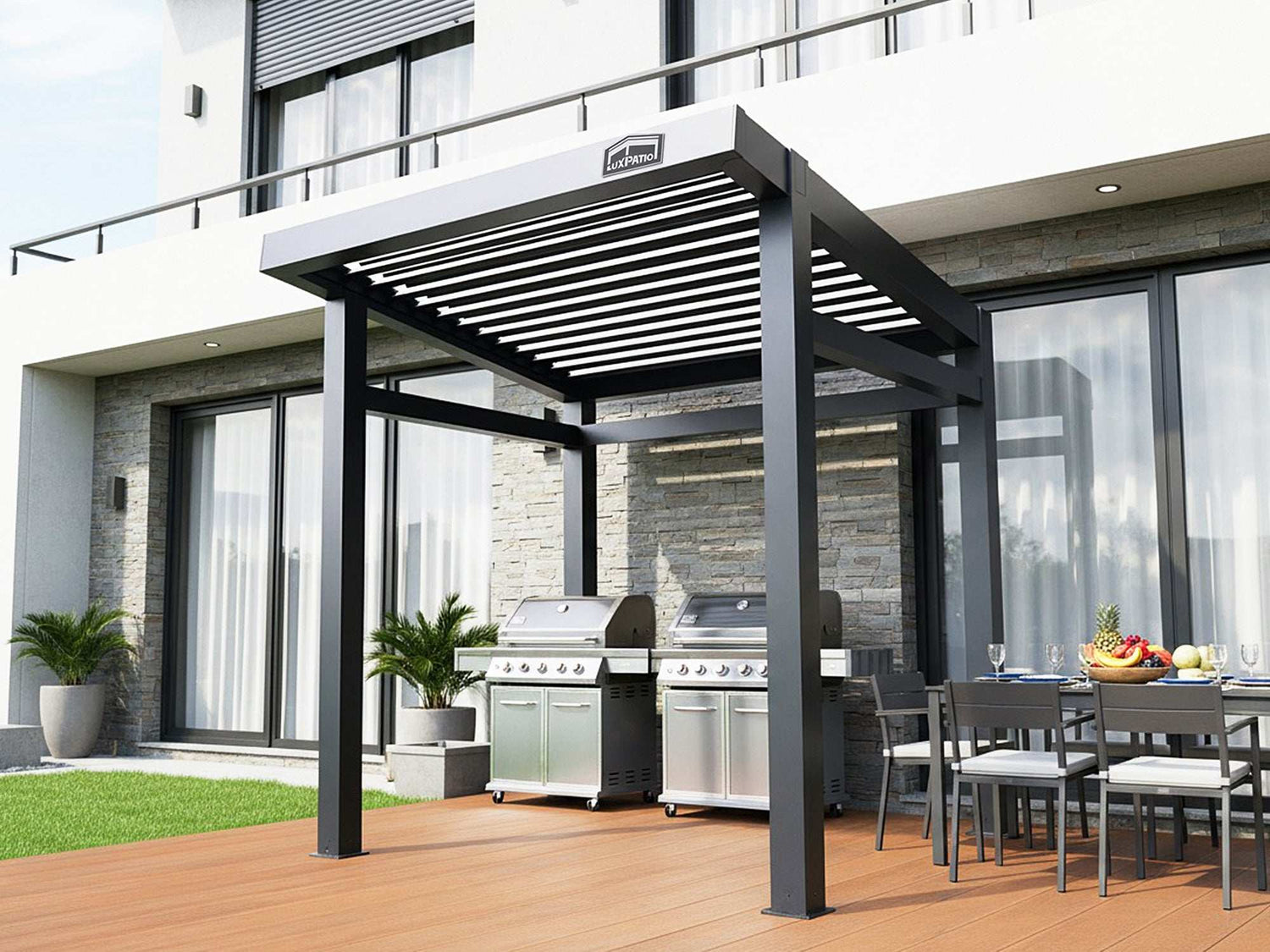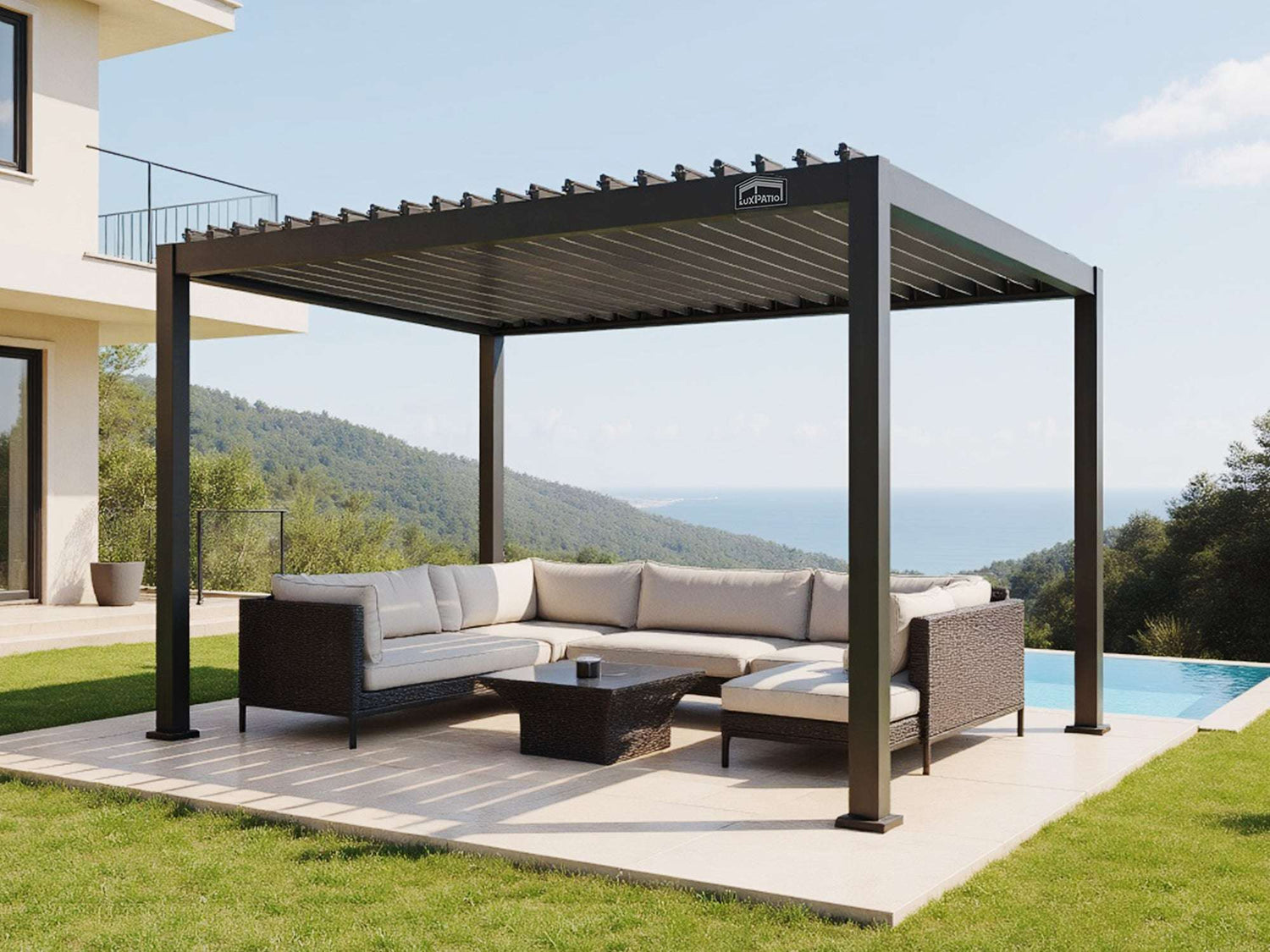A well-planned pergola can change a bright, underused slab into the spot where family and friends naturally gather. Before you think about colors and furniture, one decision sits at the top of the list: choose a freestanding pergola on its own posts or a wall-mounted pergola that connects to the house. That choice affects structure, permits, waterproofing, budget, and how the space feels every single day.
Freestanding vs Wall-Mounted Pergola: Side-by-Side Comparison
It helps to look at both styles next to each other before you lock in a design.
Basic Structure and Support
A freestanding pergola stands on its own. Four or more posts anchor into concrete, pavers with a hidden pad, or a reinforced deck, and all loads travel straight into the ground.
A wall-mounted pergola (often called an attached pergola) fastens a rear beam or brackets to a structural wall, then uses front posts for support. Part of the weight flows into the house, so fasteners, wall framing, and flashing matter much more.
Space and Layout Flexibility on Your Patio
Freestanding structures can sit almost anywhere with proper support. They work over a poolside lounge, in a quiet garden corner, or in the center of a large yard where you want a true outdoor room.
Wall-mounted layouts hug the house. They usually extend an existing patio outside sliding doors or the kitchen, so people step directly from the living space into shade without crossing open the sun.
Shade, Weather Protection, and Privacy
A freestanding design lets you place shade exactly where the sun hits hardest. You can rotate the frame, shift it a few feet, or add privacy screens on any side to block a neighbor's window.
An attached option focuses protection at doors and nearby windows. Rain and sun hit the pergola roof first, then reach the patio. When flashing and sealant are handled well, thresholds, door frames, and flooring stay cleaner and drier.

Cost, Permits, and Ongoing Maintenance
Freestanding pergolas usually need more posts, base plates, and concrete. That can raise material and labor costs, although permits sometimes stay simpler because the house shell is untouched.
Wall-mounted pergolas may use less structure, but ask for careful design on the wall. Many cities look closely at projects that fasten to the house. Over time, you inspect flashing, sealant, and brackets, while freestanding designs ask for checks at footings, hardware, and post bases.
| Aspect | Freestanding Pergola | Wall-Mounted Pergola |
| Primary support | Four or more posts and footings | Wall connection plus front posts |
| Typical location | Pool, garden, yard corners, detached lounge areas | Directly off doors, over an existing patio |
| Impact on exterior | Leaves walls and siding intact | Penetrates siding, brick or stucco |
| Main long-term risk | Weak footings or undersized posts | Leaks or loose ledger and brackets |
The Case for Freestanding Pergolas
Some yards almost ask for a separate covered spot away from the house. In those situations, a freestanding layout usually feels more natural and keeps the house structure out of the risk zone.
When Freestanding Pergolas Make the Most Sense
This style fits homes where the best seating area sits deeper in the yard. Picture a fire pit near the fence, a hot tub in one corner, or a pool deck that deserves its own roofline. It also works well when the rear wall is mostly glass or has complex trim and details that you prefer not to drill into.
Key Advantages of a Freestanding Pergola
A freestanding pergola behaves like an independent outdoor room. You set post locations around furniture and traffic paths instead of chasing studs and joists inside a wall. Since the building envelope stays intact, future window changes, siding upgrades, or repainting are easier. For many owners, that peace of mind matters as much as looks.
Drawbacks and Limitations to Plan Around
Extra posts and deeper footings bring cost and layout tradeoffs. On a very small slab or deck, four posts can make the space feel cramped. Local codes may cap height, total covered area, or distance to property lines, so you still need to confirm clearances. If you place posts without thinking about views, tall corners can block sightlines from the living room.
Best Locations for a Freestanding Outdoor Pergola
Strong candidates include pool decks, fire pit circles, property edges with long views, and standalone outdoor kitchens. A freestanding patio pergola near a fence can frame the yard while keeping the center open for kids, pets, and lawn games.
The Allure of Wall-Mounted Pergolas
In many homes, daily life revolves around a single back door. Snacks, drinks, guests, pets, and kids all pass through that opening. For this pattern, a pergola tied to the house often gives the smoothest experience.
What Counts as a Wall-Mounted or Attached Pergola
A wall-mounted pergola fastens a rear beam or heavy brackets to a structural portion of the wall and then rests on front posts. Visually, it reads as an extension of the roof and can make the patio feel like a continuation of the living room or kitchen.
Benefits of Attaching a Pergola to Your House
Attaching the frame brings shade right to the threshold. People step into cover in a single move instead of crossing a strip of glare or rain. Lights and fans can usually tie into nearby circuits with short runs. On narrow patios, a wall-mounted pergola leaves more clear floor area because posts can sit tighter to the edge.
Structural and Waterproofing Challenges
Once the structure connects to the wall, every screw and every strip of metal flashing matters. Fasteners should bite into framing, not only siding or stucco. Openings around the ledger or brackets need proper flashing to send water outward and away. If those details are rushed, small leaks can slowly damage sheathing, insulation, and interior finishes.
Ideal Wall Conditions and Home Types
Straight rear walls with conventional wood framing tend to work best. Brick over framing can also be suitable with the right anchors and flashing. Full glass walls, heavy stone cladding, or complex bump-outs raise the difficulty and often tilt the decision back toward a freestanding option.
Pergola Installation Considerations: What You Need to Know
A smart design still depends on solid execution. A few principles of pergola installation make any style safer, sturdier, and easier to live with.
Foundation and Anchoring Requirements
Posts need something better than loose soil or floating pavers. Concrete footings or a continuous slab give the most reliable base. On an existing deck, installers often add blocking or extra beams before bolting down post plates. Paver patios may need hidden pads so posts do not walk out of position over time.
Wall Attachments, Flashing, and Leak Prevention
For attached frames, ledgers, and brackets should connect directly to structural members. Flashing runs above and sometimes behind these pieces to steer water away from the wall. Sealant fills hairline gaps but should not act alone. A quick visual check each season for cracks, stains, or rust can prevent small issues from becoming expensive repairs.
Electrical, Drainage, and Building Codes
Lights, fans, and outlets belong in weather-rated fixtures with proper boxes and conduit. Some modern systems hide drainage inside beams and posts so rain leaves the roof at planned spots. Local rules may set limits on total roofed area, height, and distance to property lines, so it helps to confirm requirements before you pour a single footing.
DIY vs Professional Pergola Installation
A small kit on a simple slab might suit an experienced DIY owner. Once you introduce ledgers on the house, complex foundations, or electrical work, a licensed professional usually saves time and risk. A good installer understands local codes, knows how inspectors think and can back the work with a warranty.
How to Choose Between Freestanding and Wall-Mounted Pergolas
With the differences clear, the final step is matching them to your specific yard, house and habits.
Patio Layout and Traffic Flow Review
Imagine an ordinary weekend afternoon. People carry food out, kids race through the door, the dog follows anyone holding a plate. If activity clusters within a few feet of the back wall, an attached layout often feels logical and efficient. If the true hangout area is halfway across the yard, a freestanding structure over that zone usually serves better.
Budget, Timeline and Maintenance Expectations
Freestanding designs tend to spend more on concrete and posts, yet most work happens away from the house, which can shorten approvals and simplify repairs later. Wall-mounted designs cut some material costs but add hours of planning around structure, flashing and inspections. Think about who will monitor sealant, brackets and finishes in the years ahead.
A Simple Decision Checklist for Homeowners
These quick prompts often reveal the right direction:
- Does the rear wall have large glass panels or delicate finishes that you prefer not to disturb
- Is your favorite seating area close to the house or deeper in the yard
- How important is it for the back door itself to sit under cover
- Do you feel comfortable modifying the house structure, or do you lean toward keeping it untouched
Once you answer honestly, you usually feel a clear pull toward either a freestanding pergola or a wall-mounted pergola.
Which Pergola Type is Right for You?
If your life revolves around the back door and the wall can safely accept a ledger, a wall-mounted pergola typically gives you the most convenient shade and the cleanest indoor-to-outdoor transition. If the best spot for relaxing sits away from the house, or you feel uneasy about opening up the exterior wall, a well-anchored freestanding pergola delivers shade, privacy and flexibility with less impact on the structure. Combine layout, wall conditions, local rules, budget and your comfort with maintenance, and the better choice almost always becomes obvious.
Frequently Asked Questions About Pergola Types
Q1: Do I Need a Permit for a Freestanding or Wall-Mounted Pergola?
Many cities ask for permits once a pergola reaches certain height or size limits, uses fixed footings or attaches to the house. Wall-mounted designs often receive closer review. A short call to the local building department removes the guesswork.
Q2: Which Pergola Type Is Better for a Small Patio or Deck?
Small patios and decks usually benefit from simple lines and fewer posts. If the wall can carry the load, an attached frame keeps more floor clear. If the wall is not suitable, a compact freestanding frame with posts tight to the edges still works.
Q3: Can I Mount a Pergola on Vinyl Siding or Stucco Walls?
It is possible, but fasteners should not rely on siding or stucco alone. Installers typically tie brackets into framing, add blocking if needed and then rebuild the exterior with proper flashing and sealant. That way the wall keeps water out while carrying the new load.
Q4: Are Freestanding Pergolas Stable Enough for High Winds?
With correctly sized posts, beams, anchors and footings, a freestanding design can perform well in windy conditions. The key is following engineered spacing and keeping hardware in good shape. Before a big storm, closing louvers or securing panels adds another layer of protection.
Q5: What Is the Best Pergola Setup for an Outdoor Kitchen?
Cooking zones create heat, smoke and grease, so they need space and airflow. Many owners prefer a freestanding frame set a short distance from the wall to protect finishes and improve ventilation. If the kitchen must sit against the house, use non-combustible surfaces and plan a clear path for smoke to escape.










